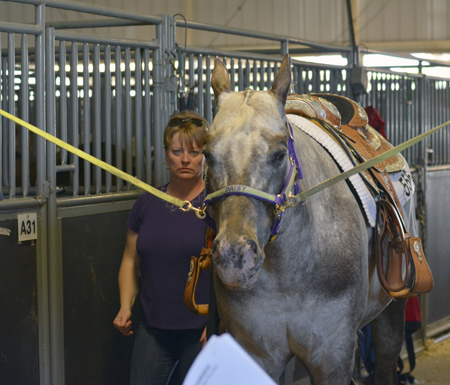 With the arrival of the spring and summer, horse shows generally kick into high gear. It’s a great time of year for many horse enthusiasts, but it also a season that generates a lot of business for lawyers. Horse shows, while fun and entertaining, can be filled with hidden dangers that lead to an abundance of lawsuits. In this article, we will take a look at some of the more common hazards encountered at horse shows and how to avoid them so that you don’t end up spending more time in the courtroom than the arena.
With the arrival of the spring and summer, horse shows generally kick into high gear. It’s a great time of year for many horse enthusiasts, but it also a season that generates a lot of business for lawyers. Horse shows, while fun and entertaining, can be filled with hidden dangers that lead to an abundance of lawsuits. In this article, we will take a look at some of the more common hazards encountered at horse shows and how to avoid them so that you don’t end up spending more time in the courtroom than the arena.
Safety Starts at Home
The first step to avoiding danger and injury at a horse show starts right in your own barn. There are some simple, common sense precautions that you can take at home to avoid headache and heartache down the road.
Tack Check: Check and double check your tack before you venture out. Make sure your halter and lead rope are the right size and strength for your horse. What worked for your spouse’s mare might not be a good fit for your son’s stallion. In addition, all equipment should be inspected for signs of wear and weakness. If not treated properly, leather straps can become dried and cracked over a long winter and can easily snap or fray.
The rivets, screws or ties that attach the bit to the reins need to be secure and all metal buckles and hinges should be checked for signs of rust. Of course, don’t forget the saddle and girth, making sure the girth is long and strong enough to avoid having undue pressure placed on it. Also, the cinch and stirrups should be strong and free from excessive wear that could cause them to break.
The last place you want to discover that your tack is faulty is while you’re riding at a horse show. You risk injury to yourself and your horse and you could be legally responsible for injury caused to others and to horse show property of others for which you may then be legally responsible.
Helmets are a Must: Every year, over 10,000 people are treated in emergency rooms across the United States for horse-related traumatic brain/head injury. I can almost guarantee that the majority of these occurred because either a helmet was not worn or was ill-fitting or damaged. Double and triple check your riding helmets, making sure they are sized properly, and with straps in good, strong condition.
Make Sure Your Horse is Ready: Test your horse’s temperament before taking him to the show. A horse may be calm and easy to handle while riding on the farm, but horse shows provide a different environment, filled with noise, people, other animals, different smells, and so forth. Even the most easy-going horse can have a bad reaction to such an atmosphere, and may act out, kicking, biting, or being generally uncooperative, which can leave you open to liability should he hurt someone or damage property.
 Safety at the Show
Safety at the Show
Some aspects of horse show safety may be out of your control, but there are many potential hazards that you can avoid by exercising proper diligence.
Horse & Tack Stalls: Examine the stalls provided at the horse show for any hidden dangers, such as loose boards, splintered wood, exposed wires, exposed nails, or unsanitary conditions. If any unsafe conditions such as these are present, report it immediately to management. This can help avoid unnecessary injury to you or your horse and the consequent legal complications,
Wash Racks: Often overlooked, these areas can be hazards waiting to happen. Make sure you check the wash racks for poor drainage issues that can cause slippery conditions. Also check for loose bricks or concrete that can injure you or your horse. Again, if you see anything that seems dangerous or not as it should be, report it to management and avoid using the area.
Indoor/Outdoor Rings: It is your right and perhaps even your obligation to take a look at the rings you are going to be using before taking your horse into them. Keep an eye out for areas of uneven, unsafe footing and dangerous fence line objects. Also, be aware of any low hanging lighting, rafters and archways—they may seem fine when you’re walking the ground, but when you are mounted on your horse, they could get in the way. In the same respect, take note of the placement of banners, flags, etc. that may flap or make noises that might spook your horse. Again, being aware of these hidden potential dangers can help you avoid them, avoid injury to yourself and others, and avoid the legal repercussions that might result.
Don’t Tie Your Horse Just Anywhere: Sometimes at a horse show you might feel rushed, and it may seem more convenient to tie your horse to the most readily available object.
Don’t do it, unless that object happens to be a sturdy fence, post, or trailer with tie hooks or a specific hitching rail. It is worth the extra time to make sure your horse is tied somewhere securely. Tying a horse to a trailer that is not hooked to a vehicle may be a popular habit but is incredibly unsafe unless the trailer is properly blocked or secured. I had one client who did so, not realizing that the trailer was on a very slight incline and, with a tug or two from the horse, the trailer rolled, causing all kinds of havoc. It’s just not worth the risk.
In the same vein, don’t ever attach a horse to an exhibitor or rider. I’ve seen some horse owners actually wrap a lead around the hand or arm of another person. A horse is a very powerful animal, and this practice can lead to devastating injuries for which you will likely be legally responsible. Just don’t do it.
Grooming: Don’t let anyone (including yourself) groom your horse without the proper footwear. Sneakers won’t cut it. Tennis shoes won’t cut it. Flip-flops definitely won’t cut it. No one should be grooming your horse unless they have boots or other hard-toed shoes on their feet. Bad things happen to unprotected toes when an impatient horse takes a step in the wrong direction—and the responsibility will probably fall to you for any resultant injuries.
Changing the Halter: In the rush and excitement of a horse show, many a horse handler has tried to change the leather or nylon work halter to a show halter while the horse is out of the stall. This is a mistake and one of the most notorious places for a keyed-up horse to make a quick break for it. Nothing screams liability quite like a runaway horse at a horse show. Be smart—take your horse back into the stall to swap out halters. Or, at the very least, make sure you have a few other people around to assist if you need to change the halter while the horse is outside.
Mati Jarve is the managing partner of the Marlton, New Jersey law firm of Jarve Kaplan Granato, LLC. He is certified by the New Jersey Supreme Court as a Civil Trial Attorney and the National Board of Trial Attorneys as a Trial Advocate. Licensed in New Jersey, Pennsylvania and Arizona, he maintains a national practice in civil litigation, including equine related issues. This article is for informational purposes only and is not intended to be legal advice.
If you have a specific legal question or problem you should consult with an experienced and knowledgeable equine law attorney. Questions, comments or suggestions can be e-mailed to mjarve@nj-triallawyers.com, by visiting www.nj-triallawyers.com.


You must be logged in to post a comment Login